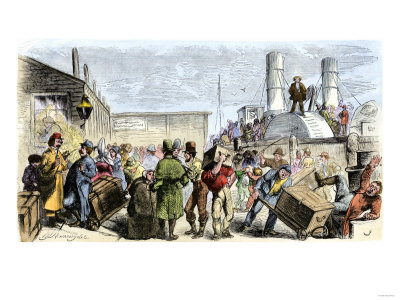The evolution of transportation allowed for explosive growth in immigration and the sizes of Americas cities. In New York City the increase in immigrants from Europe caused cities to overcrowd. This forced the development of public ferry lines. Before the public ferry system was established, transportation between NYC, its boroughs and the main land territory bordering the Hudson river, was possible only because of private, local shipowners that had to be hired to make the trip. This private ferrying system prevented the expansion of the population, as its limited capacity and its prices effectively made it impossible for the lower classes to travel. With public transportation becoming available in early and mid 19th century, the immigrant population were given a way to settle in different parts of the land.
Transportation also allowed the immigrants arriving in New York City to expand across the country into places such as San Francisco, California. The only way European immigrant could get to California and other far off American land was by ship, that had to travel around south America then north to California, or by land, which was a quite long journey through hostile Indian territory and the harsh American landscape. With the creation of the train and its connection with the east coast, the west was opened to settlement by immigrants. Since the major stations for trains were cities and, compared to NYC, were small in size, arriving immigrants tended to stay in the cities as overcrowding was not as established as in NYC. That will not always be the case as those same cities, such as San Francisco would eventually outgrow its limit to house all the people arriving and the growth of its native population, causing an opening up of land outside cities in California to settlement by new immigrants and the native population tired of city life.
A main difference between NYC and San Francisco’s increase in immigration is the difference in the nationalities of the immigrants. In NYC the majority of its immigrants were made up of Europeans,specifically Irish ,Germans and Italians.This is not to say that these nationalities did not find their way to Californians cities, but they did stick to the north eastern region of America. The western part of America’s immigrants were made up of people from Spain and other Spanish groups,such as Mexicans. This is due ,in major part, to the fact that San Francisco was once a part of the Spanish empire and its language being Spanish.

Ferry Building 1889, foot of Market Street Photo: Greg Gaar Collection, San Francisco, CA








 Difference
Difference


 ave their share of differences and similarities. The most obvious difference is that one is a city from the North while the other is a city from the South. Each has it’s own different lifestyle. With the North being more notable for freedom for slaves and industrial services, the South was none for its intolerance towards slave freedom and their agriculturalist lifestyle. For New Orleans, this wasn’t held completely true. New Orleans “resembled northern counterparts in their commercial functions and social complexity” ( Chudacoff and Smith page 72) Although they were one of the few cities that had commercial functions, the business people relied heavily on the Northern capital and markets. This big one similarity, one difference between New Orleans and New York was that in New York diversity was well known and in a sense accepted. In New Orleans the French speaking people and the English speaking people had to be divided in the city “between a French quarter and an American Quarter, separated by a street with a broad medican called the Neutral Zone” (Chudacoff and Smith page 67) The diverse population in New York was in a sense mixed weren’t living in their own sections as was the case in New Orleans.
ave their share of differences and similarities. The most obvious difference is that one is a city from the North while the other is a city from the South. Each has it’s own different lifestyle. With the North being more notable for freedom for slaves and industrial services, the South was none for its intolerance towards slave freedom and their agriculturalist lifestyle. For New Orleans, this wasn’t held completely true. New Orleans “resembled northern counterparts in their commercial functions and social complexity” ( Chudacoff and Smith page 72) Although they were one of the few cities that had commercial functions, the business people relied heavily on the Northern capital and markets. This big one similarity, one difference between New Orleans and New York was that in New York diversity was well known and in a sense accepted. In New Orleans the French speaking people and the English speaking people had to be divided in the city “between a French quarter and an American Quarter, separated by a street with a broad medican called the Neutral Zone” (Chudacoff and Smith page 67) The diverse population in New York was in a sense mixed weren’t living in their own sections as was the case in New Orleans.







